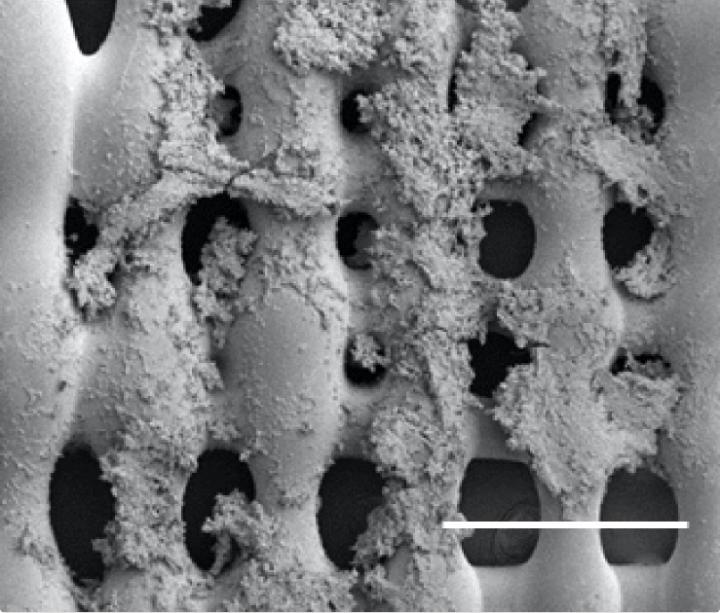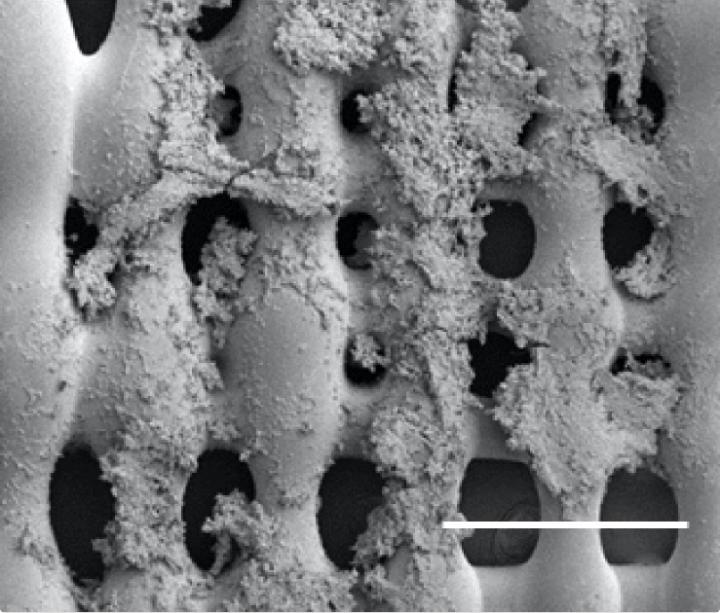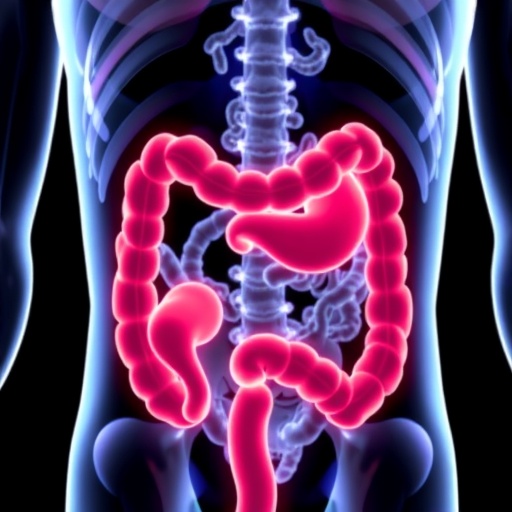
Credit: Mikos Research Group/Rice University
Testing treatments for bone cancer tumors may get easier with new enhancements to sophisticated support structures that mimic their biological environment, according to Rice University scientists.
A team led by Rice bioengineer Antonios Mikos has enhanced its three-dimensional printed scaffold to see how Ewing's sarcoma (bone cancer) cells respond to stimuli, especially shear stress, the force experienced by tumors as viscous fluid such as blood flows through bone. The researchers determined the structure of a scaffold, natural or not, has a very real effect on how cells express signaling proteins that help cancer grow.
The size and shape of pores and scaffold porosity — the percent of empty space in a structure created by pores — can impact cell attachment, alter the permeability of media and nutrients and facilitate cell migration, according to the researchers. The scientists said 3-D printing allows them to get closer than ever to mimicking the architecture of real bone.
The research is detailed in the American Chemical Society journal ACS Biomaterials Science and Engineering.
The scaffold itself is special, according to Mikos. The bone-like printed polymer contains pores of varying sizes to constrain fluids that flow through and apply varying degrees of shear stress to the tumor cells, depending on the scaffold's orientation in relation to the flow.
"We aim to develop tumor models that can capture the complexity of tumors in vitro and can be used for drug testing, thus providing a platform for drug development while reducing the associated cost," Mikos said. He noted that by varying the scaffold architecture, they can change the mechanical environment through which fluids flow and the magnitude of shear stress exerted on tumor cells.
Flat sections of scaffold were printed with pores in one of three sizes: 0.2, 0.6 and 1 millimeter. Three layers of each were stacked to make each 3-D scaffold, and these were seeded with tumor cells and placed in a flow perfusion reactor that mimics the push and pull of fluids and tissues in a biological environment. This makes simulations much more realistic than growing cells in a flat petri dish, Mikos said.
The researchers found that cells proliferated far better under flow than in conditions with no fluid flow. When the fluid began to flow, layers with the smallest pores, which restrict permeability, showed significantly more proliferation. They also found that under flow, cells increased their production of insulin-like growth factor protein (IGF-1), a ligand on the surface of sarcoma cells and part of the signaling pathway that plays a critical role in resistance to chemotherapy. Additionally, the orientation of the 0.2, 0.6 and 1 millimeter pore sizes played a role in how much IGF-1 the cells produced.
They suspected that the combination of shear stress and scaffold orientation prompted different levels of protein production.
The researchers now plan to refine their scaffold-printing process to study metastasis and test tumors' response to drugs.
###
Rice Ph.D. alumnus Jordan Trachtenberg, now an independent contractor at Rice, and alumnus Marco Santoro, now a faculty research associate at the University of Maryland, are lead authors of the study.
Co-authors are Rice graduate students Brandon Smith and Eric Molina; graduate student Cortes Williams and Vassilios Sikavitsas, a professor at the University of Oklahoma; graduate student Charlotte Piard and John Fisher, the Fischell Family Distinguished Professor at the University of Maryland; postdoctoral researcher Jesse Placone of the University of California, San Diego; and research assistant Brian Menegaz, senior research scientist Salah-Eddine Lamhamedi-Cherradi and Associate Professor Joseph Ludwig, all at the University of Texas MD Anderson Cancer Center. Mikos is the Louis Calder Professor of Bioengineering and Chemical and Biomolecular Engineering and a professor of materials science and nanoengineering.
The National Institutes of Health, the Armed Forces Institute of Regenerative Medicine, the National Science Foundation and the Howard Hughes Medical Institute supported the research.
Read the abstract at http://pubs.acs.org/doi/abs/10.1021/acsbiomaterials.6b00641
This news release can be found online at http://news.rice.edu/2017/02/08/better-scaffolds-help-scientists-study-cancer/
Follow Rice News and Media Relations via Twitter @RiceUNews
Related materials:
"Cancer treatment models get real": http://news.rice.edu/2015/08/05/cancer-treatment-models-get-real-2/
Mikos Research Group: http://www.ruf.rice.edu/~mikosgrp/index.htm
Rice Department of Bioengineering: https://bioe.rice.edu
Located on a 300-acre forested campus in Houston, Rice University is consistently ranked among the nation's top 20 universities by U.S. News & World Report. Rice has highly respected schools of Architecture, Business, Continuing Studies, Engineering, Humanities, Music, Natural Sciences and Social Sciences and is home to the Baker Institute for Public Policy. With 3,910 undergraduates and 2,809 graduate students, Rice's undergraduate student-to-faculty ratio is 6-to-1. Its residential college system builds close-knit communities and lifelong friendships, just one reason why Rice is ranked No. 1 for happiest students and for lots of race/class interaction by the Princeton Review. Rice is also rated as a best value among private universities by Kiplinger's Personal Finance. To read "What they're saying about Rice," go to http://tinyurl.com/RiceUniversityoverview.
Media Contact
David Ruth
[email protected]
713-348-6327
@RiceUNews
http://news.rice.edu
############
Story Source: Materials provided by Scienmag





